
Imagine yourself as a newly-minted homeowner. You’ve recently purchased and moved into a beautiful home with a well-established lawn.
As part of your home maintenance schedule, you start to think about how to maintain this lovely lawn – mowing, watering, weeding and fertilizing all come to mind. Each of these tasks seems pretty straightforward, especially mowing and watering which happen on an as-needed basis.
But what about fertilization? When is that supposed to happen for best results?
How do you know when to fertilize your lawn?
Fertilizing seems like an easy task in and of itself. You may remember watching a parent or neighbor spreading those little white fertilizer pellets on lawns in your neighborhood.
What you may not remember about that process is when it happens and why. There are several factors you should consider before deciding when to fertilize your lawn. Here are a handful of factors you might want to consider.
Learn about your grasses
The first thing to know before fertilizing is what types of grasses you have in your yard. The growing season of your grass will determine when you should fertilize to give your yard the energy boost it needs.
Several common types of grass in the San Antonio area are Bermuda, Buffalo, Zoysia, and St. Augustine. These are all warm-season grasses, which means they have their peak growing season in the warm summer months.
For the greenest warm-season grass, plan the first fertilization of the year in April or May, to allow time for the nutrients to absorb before rapid growth starts.
If you have any cool-season grasses, the optimal start time is October to boost growth during winter months.
Determine your maintenance levels
Now that you know the appropriate time of year to start fertilizing your grass think about how much you want to maintain your lawn.
- How much mowing do you want to do?
- How much water can you afford to use?
- Regarding “cost”, you’ll want to consider both the price of water and any watering restrictions in your area.
If you are only able to water your lawn at a minimal level, and you don’t want to mow more than once per week, fertilizing your lawn only once or maybe twice per year is the best option.
If you have access to more water and don’t mind mowing once or twice per week, a more frequent fertilizer schedule of once every six to eight weeks will net you a green, healthy lawn.
Even if you can provide a lot of care to your lawn, most experts recommend fertilizing no more than every four weeks.
Choose your fertilizer
Most home and garden stores carry various types of fertilizers that all contain nitrogen, phosphorus, and potassium. The bags are labeled with the percentage of each nutrient.
Before deciding on a specific fertilizer, you may want to consider testing your soil’s pH level and reviewing your particular grasses’ nitrogen needs to ensure you choose the correct ratio of nutrients.
Saturating your yard and soil with too much nitrogen can burn off and kill grass, so err on the side of caution when it comes to chemical fertilizer.
If you’d rather steer clear of chemicals, you can also use several types of organic material to fertilize your lawn.
Organic Options
The first option (and the easiest) is to use the grass clippings from each mowing to add nutrients and fertilize your lawn – au natural. Depending on the health of your current lawn, these grass clippings can meet up to 25% of your lawn’s fertilizer needs. This can mean significant savings when you consider the cost of chemical fertilizer.
Another option growing in popularity is to use compost as fertilizer. Compost provides nutrient-rich food to both plants and soil. It also releases nitrogen slowly into plants and soil, which reduces the possibility of nitrogen leaking into groundwater.
If you’re going to use compost, plan to aerate your lawn before spreading compost. Work it around your yard with a rake or a soft broom to penetrate the newly aerated soil.
Lastly, if you’re up for an extra plant in your yard, clover is a natural nitrogen source you can grow in your yard. Clover also has the added benefit of being resistant to many common lawn pests.
Make yourself a calendar
Once you’ve gathered all your inputs, draw up a schedule of what needs to be done when. Start with the season you’re in now, and continue with your maintenance schedule until something new needs to happen (i.e., aerating, fertilizing, or checking the weed situation).
Schedule the first big fertilization of the season and the frequency of fertilizing, along with your regular watering and mowing. This calendar will help you visualize all the right times to fertilize your lawn, and how much time you’ll spend working on it.
Fertilizing is one of a handful of strategies you can use to maintain a green, healthy lawn. Take all the information you have about your grasses, lawn, and your personal maintenance preferences, and you can easily decide when it is time to fertilize your lawn.